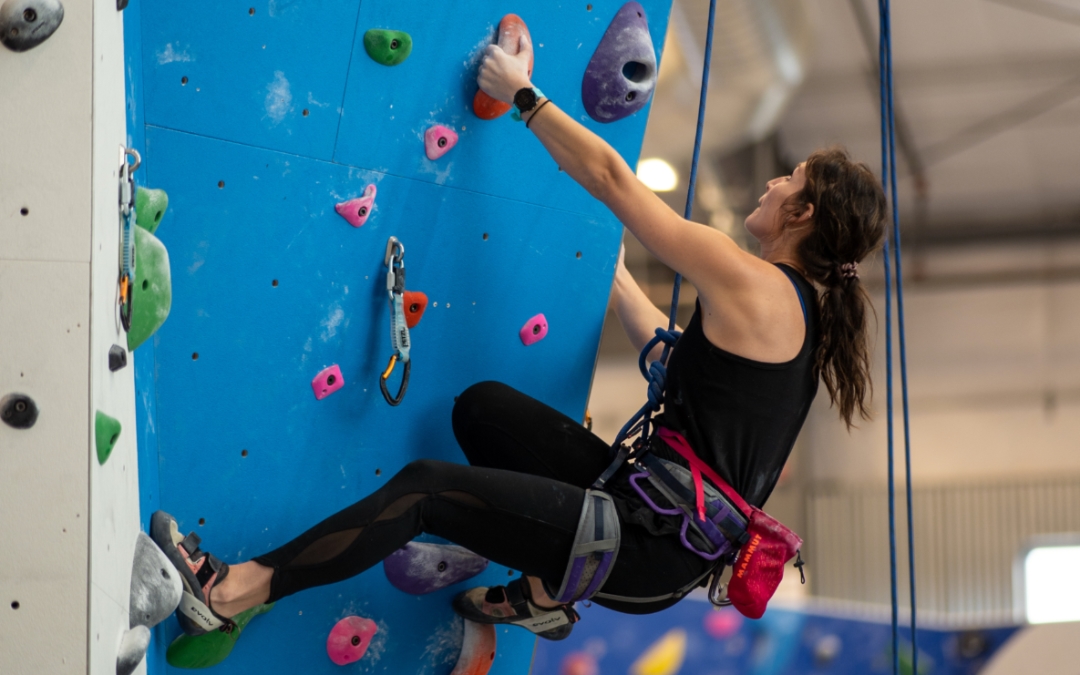By: Sam Gesicki, PT, DPT, and Carly Szemerey, PT, DPT
Bouldering. Lead climbing. Top rope. Sport. Free solo. Trad. Speed. There is so much terminology just surrounding the different disciplines of climbing and so little time. In the 2020 Olympics, the disciplines of climbing were broken down into three categories: bouldering, sport (lead), and speed.
Bouldering is climbing without rope at heights around 10 to 15 feet. Both indoors and outdoors, boulderers have crash pads under them to break their fall *if* they fall. For sport, or lead, climbing, rope is utilized to climb up to 65 feet high. The route for this is set by permanent bolts outside or by bolts inside. Speed climbing uses an auto-belay (a rope that is attached to a machine to pull up) on a 50-foot wall. As you can probably presume based on the wall heights and descriptions alone, the disciplines of these climbs are very different.
Regardless of discipline (and for quite a lot of climbers, there is cross training), every climber wants to reach a higher grade. Whether that be a V10 in bouldering, a 5.13+ in sport, or a quicker time in speed. Maximizing your project days is vital in reaching the grade or the skill you want to master. To do this, a proper warm-up routine on the wall is the part of the beta for sending.
Prepping for Projecting
Warm-ups may seem a bit different for climbers than for athletes in other sports. We have a wall to consider and the small, intricate pulleys and tendons in our fingers to prepare for our max grade. While stretching is important for mobility purposes, we have to be prepared for the demands the wall will have.
What may seem surprising is the length a warm-up should be for climbing. Regardless of climbing discipline, the climber should be completing around 120 moves a couple grades below project level and of differing styles. For bouldering, this may look like completing 8-10 routes of your warm-up grade. For sport climbing, this would be around 4-6 top ropes. Throughout these routes here are a few “drills” to utilize to improve your performance and control.
- 1) Pausing for 3 seconds before and after grabbing a hold.
- This helps improve your body control and awareness. Your body is held in a tense position while climbing, so having awareness of where your body is before and after a move will help lessen the likelihood of losing your feet on a climb.
- 2) Climbing slowly like a sloth to build control
- Going really, really slow on an entire climb helps work on eccentric control and isometric control to build strength and awareness as well.
- 3) Focusing on footwork
- Awareness of your feet is vital to climbing. While warming-up, counting foot holds, or how many times your feet move in a climb, is helpful to see how you can be the most efficient with those movements. Also, you can work on placing your foot and not moving its position on the hold while performing the subsequent arm movements. This maximizes the intentionality of the placement of your feet and the use of your lower extremity in climbing.
- 4) Hang boards and tension boards
- These are fantastic for off the wall training for your grip. However, and this is a big however, children should not be hang boarding. Their growth plates are still developing, and hang boarding will prove detrimental to that. We also want to encourage fun without too much emphasis on training.
If you are a climber, and you are struggling with an injury, we are here to help! Schedule an appointment today to help you stay on the wall.

